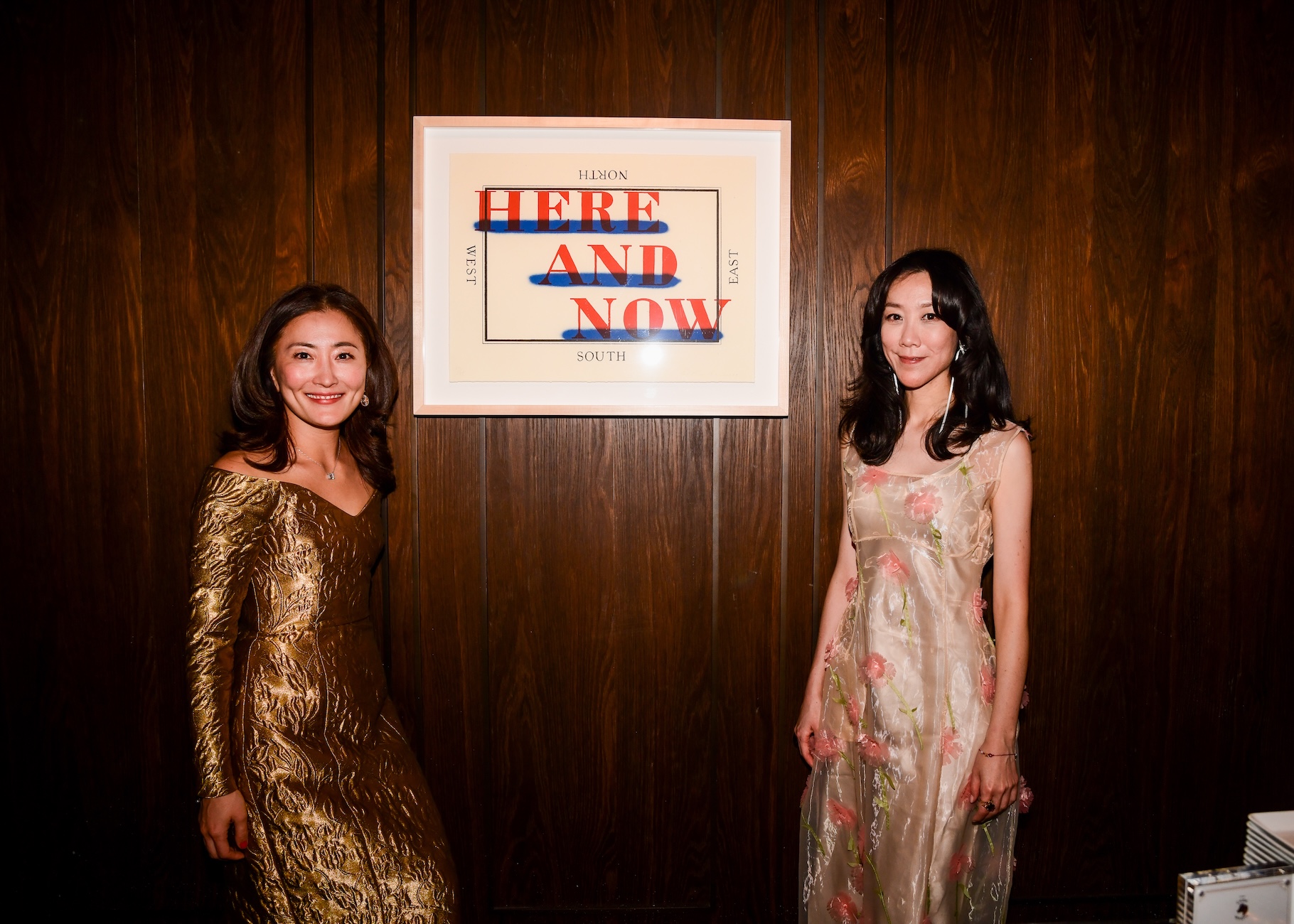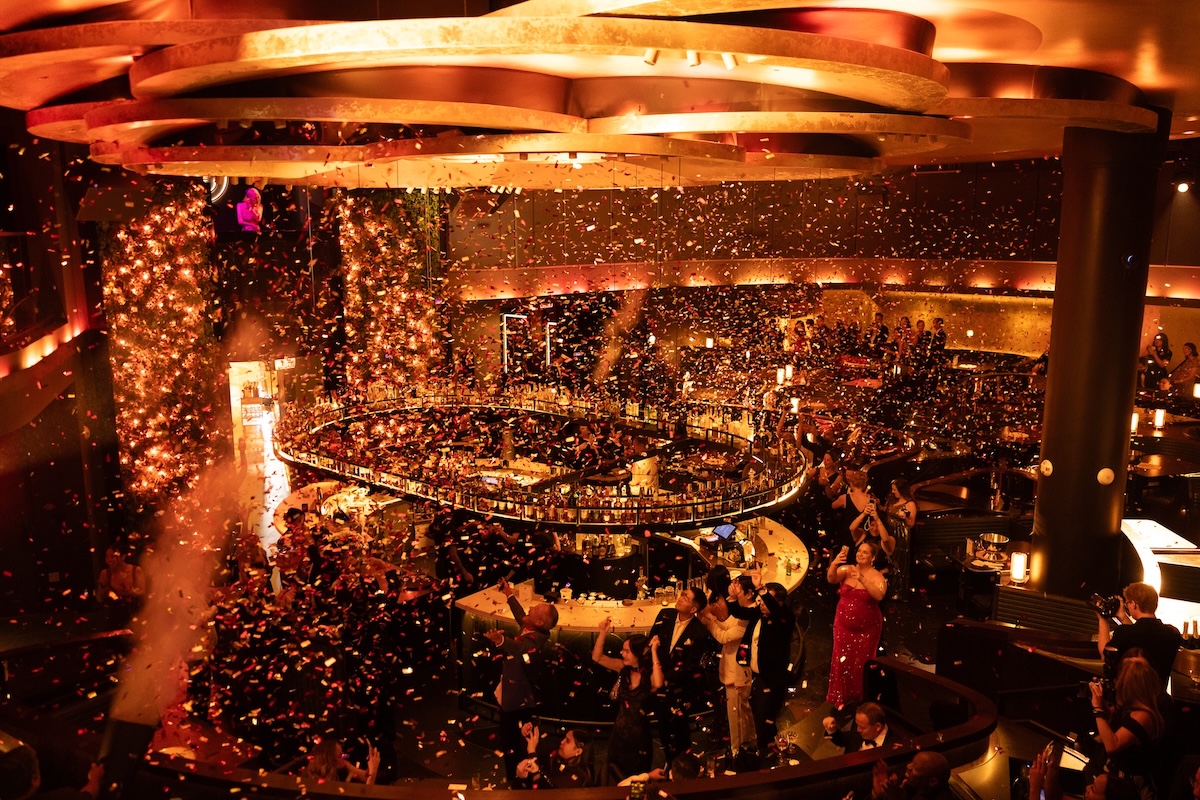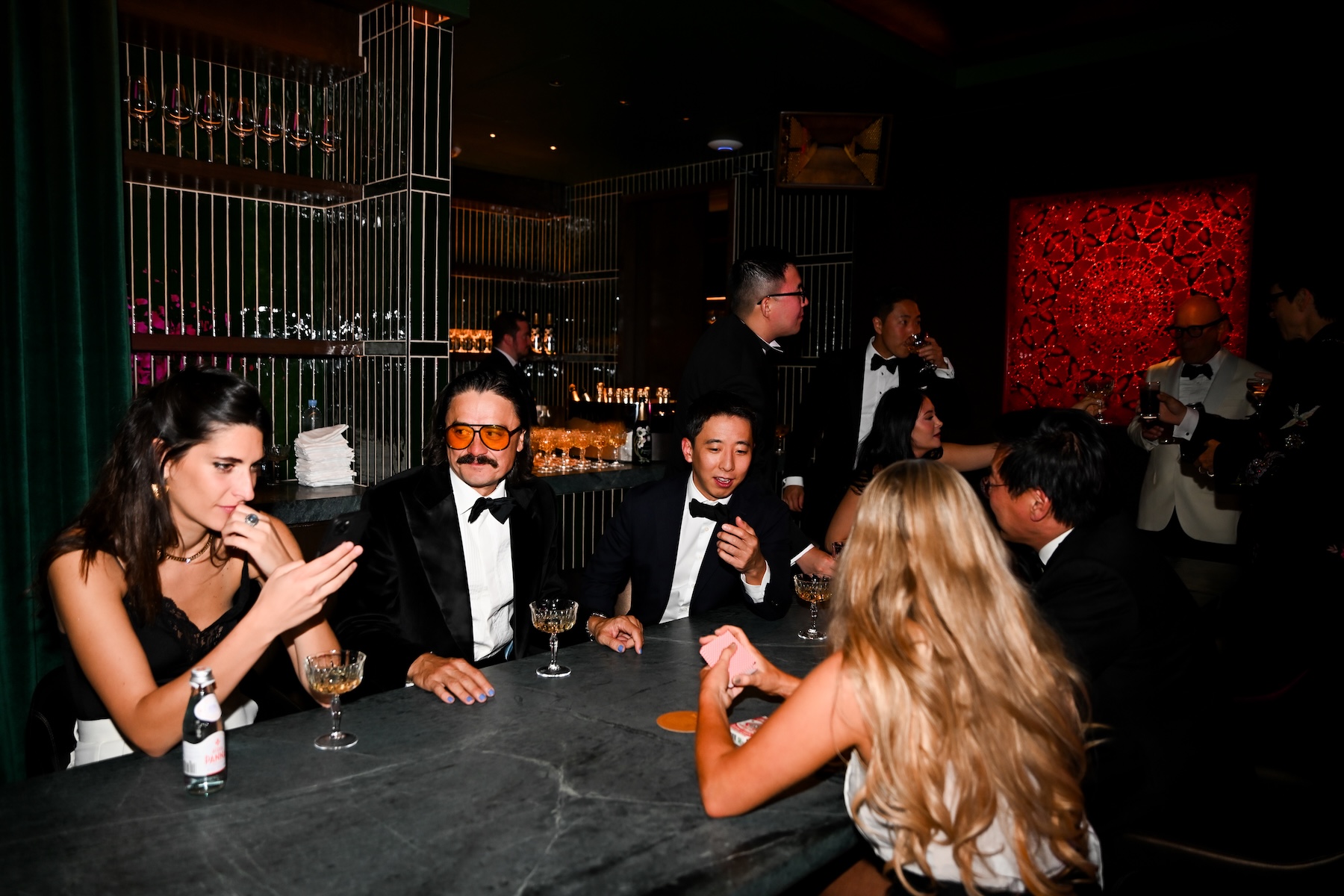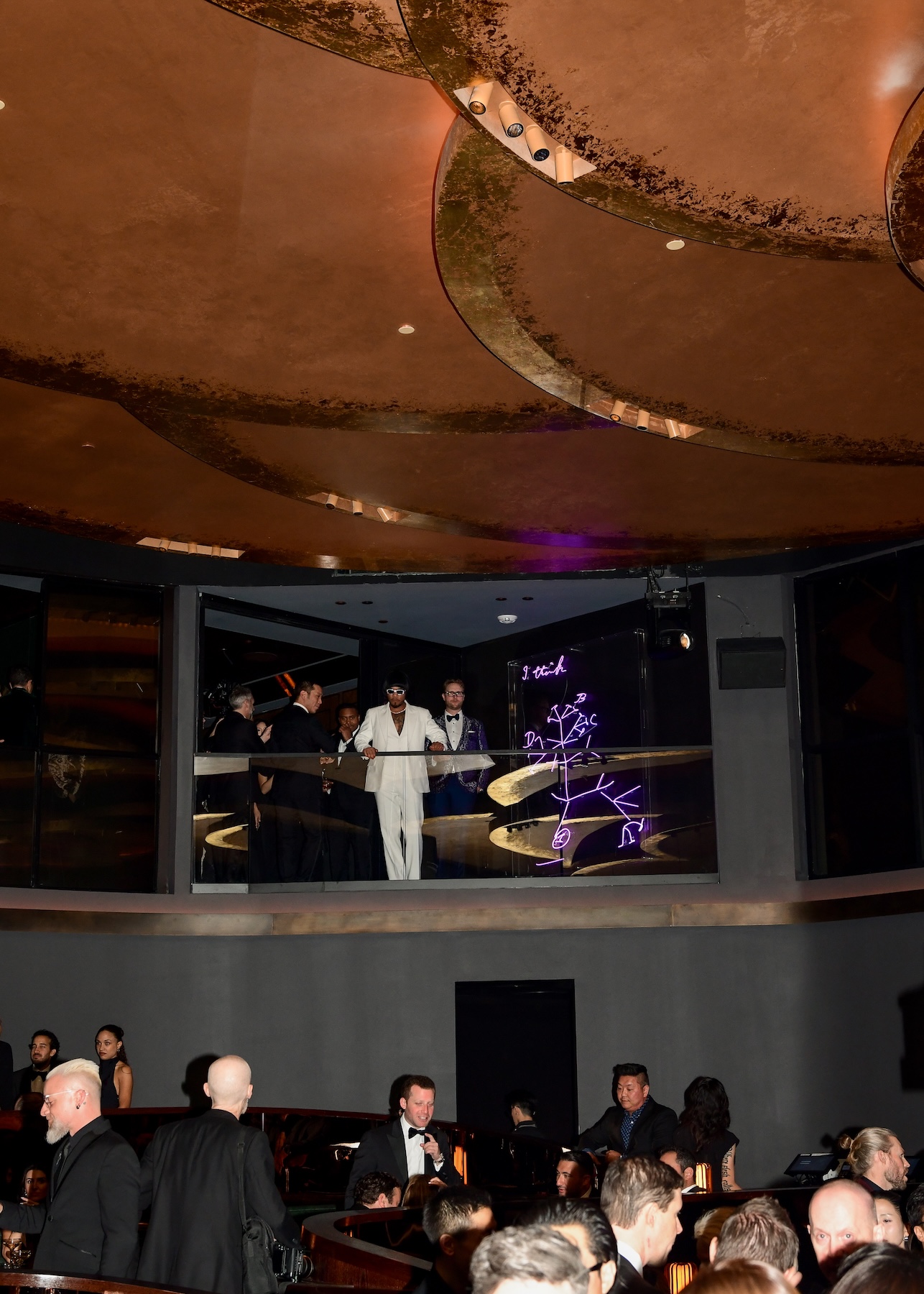F L A U N T


Michelin-starred Korean steakhouse, COTE, opened in Las Vegas at The Venetian Resort earlier this October with an art installation curated by Rosa Suehyun Kim and Ji Park Kwak, longtime best friends and founders of ARTLINE. The installation includes pieces by Joseph Kosuth, Damien Hirst, and Ed Ruscha, displayed in the private dining areas throughout the 500-seat steakhouse. In the presence of pieces by such contemporary art moguls, and with caviar, champagne, showgirls, soju, and a set from DJ Pee Wee, COTE’s opening party displayed its exact ethos: unpretentious sophistication, taste, and a good time.
This is not Rosa and Ji’s first time curating with COTE–in a standing collaboration with Gracious Hospitality Management, their Vegas project comes after their work at COTE in New York and Miami (Art Basel Miami Beach attendees might remember ARTLINE’s presentation at Art After Dark, which included works by the likes of Yoshitomo Nara and George Condo, among others).

Their intention with this installation, situated in a fine dining space, is to identify the connecting point between all that can be associated under the umbrella of luxury: beautiful art, delicious food, and the true privilege of having a space to celebrate, appreciate, and enjoy the priceless impermanency of spending time with the people we love.
ARTLINE is the public consulting division of RplusP Fine Art. Together, Rosa and Ji curate modern and contemporary artworks for corporate offices, medical offices, hotels, cultural foundations, and more. In doing so, they fulfill a sort of underrated step in an organization's self-identification and communication to the rest of the world: just as someone might dress themselves to convey a certain taste or knowledge about the world, so does ARTLINE dress the walls of public spaces where people otherwise don’t expect to see anything exceptional.
Ahead of what was perhaps the best door to be behind in Vegas on the evening of Cote’s opening night, we spoke with Rosa and Ji about the work behind their curation.

How do you both feel about opening day?
Rosa: We're excited. We knew what we were doing, of course, but coming here, I think this art program is another level here. I think it's a great addition to Las Vegas.
What was your approach to curating in Las Vegas? How did this city influence what you decided to display at this location?
Rosa: Vegas is the city of neon. You bring a neon piece to it. Joseph Kosuth–he’s a pioneer and a big name in contemporary conceptual art. We bring the serious art in the most playful, fun way, I think. The neon work is fun to look at, playful, and visually captivating. At the same time, it carries a lot of in-depth meanings. Layers and layers of meaning. The artwork itself is about paradox. The title of the artwork is “Paradox.” So it's about the meanings behind the surface.
He uses these deceptively simple visual tools to express his deeper ideas about hidden meaning, and everything is connected together, although it's not visible from the outside. So we bring this serious artwork to Las Vegas, where it's more “party.” I think it's an incredible combination of the very notion of higher, lower, seriousness, and playfulness. The clubby ambience of the artwork at the restaurant is not exactly where people expect to see serious artwork.
Ji: We wanted to bring the sophistication for sure. Being sexy and at the same time, sophisticated. It kind of shows the entirety of ARTLINE–what we want to achieve with the restaurant.
What are the ways that this curation was similar to the ones in Miami and the New York, and in what ways is it different?
Rosa: We've been working with [Gracious Hospitality Management| on other projects and have developed this text, or, textual program [Ed Ruscha’s piece reads “Here and Now”]. The text work itself, I think it directly engages the viewers. Whether you appreciate the art or not. But there is a very clear message that everyone can read. The GHM chain's philosophy, their core belief, is to come up with perfect cuisine, perfect hospitality experience, but not in a “serious” way. They want to really ensure that it's enjoyable for everyone. We really try to carry that over with our art program, and we brought the museum-quality artworks, but in a very fun and playful way that feels authentic. Vibrant, but at the same time, when you look at it, there is a depth to it. It's not just fun for your eyes, but there is something that you can think about if you want to.
Ji: It's a very unexpected space, seeing the museum-quality art [in a restaurant]. It's a very different encounter. For example, when you go to a museum and you go to a gallery, people are prepared, they're well primed. “I'm gonna go see this, this is where we're gonna see it.” But seeing the museum-quality art in the restaurant, in public places, makes people feel surprised. We love surprises in life. So I think it's a nice element.
Why do you think it's important for people to experience art in those unexpected places? Or perhaps, everyday spaces–what is exciting to you about that to, to be able to share art in this way with people?
Rosa: We've both been managing private collections for a long time. I think it's a perfect place for us to use that extensive knowledge and experience and bring it into public spaces to share with people. The knowledge and experience that we have acquired over the past 20 years is so exclusive. Art can be exclusive at times, and I don't think that's what artists intend to do with their artwork. At the end of the day, like everything else, art is a form of communication with other people. The artist intends to communicate with other people rather than to be admired on a museum wall. I mean, that could be one kind of communication, which is wonderful, but also, an artist’s intention when they are creating art is to be understood. How they are perceived could be different for everyone, depending on, I don't know, if you see an artwork at a doctor's office. That person wasn't expecting to admire an art piece when they were going into a doctor's office. Or a college kid who just went into a bar at the restaurant to grab a drink with friends, but they engage with art. I think it offers these different spaces and different types of viewers, it widens the variety and diversity of that communication with art.
We love doing corporate projects. We do get to create a way to share these wonderful minds of artists that could sometimes feel a little difficult with a lot of people. People who are not necessarily trying to understand exactly what that piece is about. They can still engage and enjoy the artwork. It could somehow connect with them. I think we love doing corporate projects for that reason.
Ji: We did a specialty plastic surgeon's office; they have a vision of their beauty…We try to read what [message] they want to deliver to their patients. When a patient comes and instead of seeing [something like] a poster, they’ll see [something like] an Alex Katz, “Five Women.” They really appreciate it–it helps the nerves. It's a very nice surprise for them.
Rosa: From the client's perspective, I think it's a great way to implement their brand image and what they are trying to pursue through their business. For the viewer's perspective, also, I think it's a great way to engage with art in a very easy, casual way.
Almost like fashion, how would you say…
Ji: It's all connected. Art, food, beauty, and fashion are all connected elements. That's what they're looking for. That's why I think it was so much fun working [on this]. We love working in these public spaces. Contemporary art in an unexpected place gives us so much joy.

Can you talk about each piece that you curated for COTE Las Vegas?
Rosa: We were talking about Joseph Kosuth, a pioneer in conceptual, contemporary art [Kosuth’s “The Paradox Of Content #1' [Violet]”, stands on a balcony overlooking the restaurant floor]. Then, the Ed Ruscha [“Here and Now” hangs on the wall of a private karaoke room] is also a staple name in contemporary art, who loves to use everyday motifs to convey deeper meaning. The vernacular and very visually clear message of Kosuth and Ruscha is carried over to Damien Hirst [Hirst’s “SUIKO” is in the members-only private dining area]. Where Kosuth and Ruscha’s work engages in very clear text messages, Hirst is sensual and seductive, and heightens those emotions. The Hirst work is on the cycle of life. It expresses life and morality. We wanted to just really play with that deep meaning.
[With Ruscha and Kosuth], signage, neon, text graphics, they use everyday, mundane [qualities] to express their deeper beliefs. Damien Hirst [does so] in a more emotional way. I think we were trying to use that theme to express our intention of carrying over that interplay of what seems maybe opposite on the surface, but at the end of the day, coexist and connect firmly in serious ideas. [The work is] high quality, it’s everyday life, something that's very contemplative, deep in their meanings, but then at the same time, people here will be dancing and eating ,having fun.
Ji: You want them [guests] to talk about the work. When you sit down in the room, for example, when you walk and you see all three beautiful pieces, we want there to be a conversation based on the table. “Here and Now”– when they sit down, they’re going to think–what does that mean, here and now?
Rosa: And maybe they’re singing…drunk and singing! “Here and Now” could be interpreted in so many different ways depending on where you are at that night, at that moment. And that's exactly what we wanted it to convey.
How can these pieces exist in a food space–there's smoke, different smells of food, and drinks. How can the physical materials withstand the different temperatures and humidities?
Rosa: You have to be at Cote to try that. They have no smoke.
Ji: Thole vent is sucking it down. They specialize in that. So that's why I think when we chose to work with the Venetian and GHM, they really appreciate the art. So they really put the elements into all the lighting, spotlighting, and they really adjusted for the art.
Rosa: I mean that GHM has been extremely supportive of art. The best partner ever you can have as an art advisor. They're really open to our ideas. They're really creative themselves. They have their own ideas and they're really ready to listen to our ideas.
Ji: They trust us. It helps us to be more creative and to create in this space. With a very meaningful and fun and sexy and sophisticated art for sure. And thanks to the Venetian–we did a full, intense presentation–but after that, they really trusted us 100%. It was like, “whatever you guys want do.”
I would imagine sometimes maybe there's a little bit of a, not pressure, but maybe people get set in their ways of how they want something, so to have that trust is important.
Ji: Totally. And the Venetian said, “We are The Venetian,” and we told them, “We are Artline.” We got this. So even though they have a series of Damien Hirst’s here, the lighting, the architecture, and the environment is all different. That's the beauty of the art. Even the same art piece can be delivered in a different way with a different architecture. That's why we love working [in these] surprise places, because it can deliver in a very different way–connecting with the arts and the space.
Rosa: She [Ji] was a pianist. I did fine art and majored in Art History. We come from very creative backgrounds, and genuinely love being creative. When clients ask that we leave room for creativity, we love that opportunity. That’s why we want to do more corporate projects, because every environment is different, every project is different, every brand is different. Within that notion, we would be happy to leverage what we know in the best way that can be represented. We want to use our knowledge in art to maximize that knowledge so that it can be delivered in the best way it could be.
Ji: We also appreciate the fact that we grew up in a family that really taught us to celebrate our emotions with the community and a few people. It kind of also reflects our lives too, interacting in these spaces.
Rosa: I feel extremely lucky to have this as my job. I love looking at beautiful things and trying to understand–you know, when you read a novel or listen to music or watch a movie, sometimes you connect to that piece so much that you feel like you know the author yourself. I think I love that experience in and of itself, and for that to be my job, I just feel extremely lucky.
Ji: I also feel very lucky that I work with my best friend, you know what I mean? I’m so very, very grateful that we both understand each other really well. We just know right away what we don’t like and what we love. There was one piece that we brought in, like, “What do you think of this?”
and I was looking at her like “Just kidding.” I know you’re not going to like it. I know we understand each other’s tastes, and we look at things in the same direction or with different directions. I’m very, very grateful that we work together.
How did you two meet initially? How did you become friends?
Rosa: We’ve been friends forever. We were both international students from Korea. The community is pretty small. We got to know each other more after college.
What have you learned about each other, about your work, about life in general, since operating ARTLINE?
Rosa: We felt like we knew each other so well in depth. Working together in that same aspect. I see Ji in a new light. I feel like I’m understanding her, 360 degrees. If I were looking at her as a friend from this angle, as a business partner from that angle, I’m understanding her more and more in depth. I’m so lucky that we had that trust built before anything. No matter what we go through, I have that trust that we’ll work it out.
Ji: Also, running a business is all about making a decision. I can kind of make a decision without approval because I know she’s going to say yes or I know she’s going to say no. I know she’s like that, so it kind of expedites our process.
Rosa: Also, because we’re friends, we have a deep level of trust. She’s going to be there and back me up. I think that trust really helps us run the business. No matter what she does, I trust her. I think that trust part is the hardest thing you can get in any relationship, whether it’s personal or it’s work. Even if you work very well with your coworkers, it’s hard to achieve that level of trust, I think. We are lucky in that way.
Ji: Yes, we are very lucky that way.